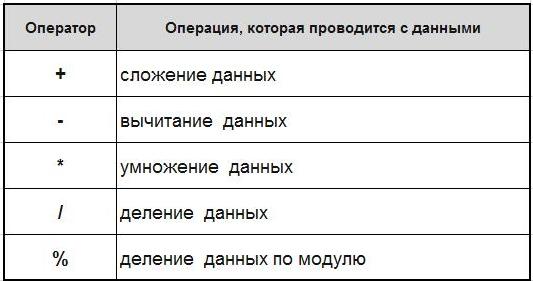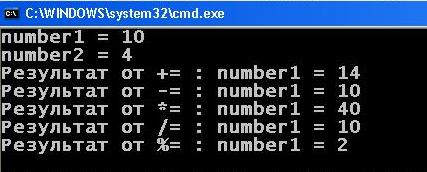 In modern life, it is very difficult to do without arithmetic operations. We constantly have something to consider: fold, multiply, subtract, share, etc.. Programming – not an exception. you in 99.9% cases have to use them, when writing your programs. They should not be afraid of – all arithmetic operations – easy, understandable and familiar to us from school.
In modern life, it is very difficult to do without arithmetic operations. We constantly have something to consider: fold, multiply, subtract, share, etc.. Programming – not an exception. you in 99.9% cases have to use them, when writing your programs. They should not be afraid of – all arithmetic operations – easy, understandable and familiar to us from school.
Consider the arithmetic operation in the following table.

Here, particular attention should be paid to the modulus (%). This operation is often used in solving various tasks. An example of its application: if we need to divide modulo 9 on 4 (9 % 4), the result is 1 (this residue – then, What's on 4 It is no longer divided into whole). More examples: 20 % 8 = 4 ( 8 placed in the 20 2 fold: 8 * 2 = 16, 20 – 16 = 4 remainder of the division ), 3 % 2 = 1, 99 % 10 = 9, 9 % 10 = 9. Important:
- modulo division applies only to integer variables ;
- can not be divided according to the module 0;
Example:
1 2 3 4 5 6 7 8 9 10 11 12 13 14 15 16 17 18 19 20 21 | #include <iostream> using namespace std; int main() { setlocale(LC_ALL, "rus"); int number1 = 18; int number2 = 4; cout << "number1 = " << number1 << endl; cout << "number2 = " << number2 << endl; cout << "number1 + number2 = " << number1 + number2 << endl; cout << "number1 - number2 = " << number1 - number2 << endl; cout << "number1 * number2 = " << number1 * number2 << endl; cout << "number1 / number2 = " << number1 / number2 << endl; cout << "number1 % number2 = " << number1 % number2 << endl; cout << endl; return 0; } |
Here you can see, the fission num1 on num2, it appeared on the screen only the integer part of – 4 (although the exact value 4.5). The fractional part is cut, because the variables are defined, as integer – int. As a result of the modulo we see 2 – what is left in the remainder of the division 18 on 4.
Another thing I would like to consider in this article – so-called combined (or compound) statements. In addition to its role of arithmetic, they simultaneously act as a variable assignment. Here is a list of composite statements:

Illustrate:
1 2 3 4 5 6 7 8 9 10 11 12 13 14 15 16 17 18 19 20 21 22 23 24 25 26 27 28 | #include <iostream> using namespace std; int main() { setlocale(LC_ALL, "rus"); int number1 = 10; int number2 = 4; cout << "number1 = " << number1 << endl; cout << "number2 = " << number2 << endl; number1 += number2; // эквивалентно записи number1 = number1 + number2 cout << "Результат от += : " << "number1 = " << number1 << endl; number1 -= number2; // number1 = number1 - number2 и т.д. cout << "Результат от -= : " << "number1 = " << number1 << endl; number1 *= number2; cout << "Результат от *= : " << "number1 = " << number1 << endl; number1 /= number2; cout << "Результат от /= : " << "number1 = " << number1 << endl; number1 %= number2; cout << "Результат от %= : " << "number1 = " << number1 << endl; cout << endl; return 0; } |
Although for someone, at first sight, these statements may seem confusing, trust, to them very quickly and you can get used to successfully apply in their programs. You just need some practice with their use. Your code will be more compact look. Same, the use of combined statemants is a sign of good programming. Therefore,, Though not an error in the code separately from the use of the addition assignment – number1 = number1 + number2;, preferable to use a shortened version of the recording number1 = number2;
Result:
In this article only examined binary statements – those which are used for arithmetic operations with two variables (operand). In one of the following, we look at unary statemants (for operations on one variable) – increment and decrement, and next – and ternarnım statement (which requires three operands).
It is desirable to consolidate the knowledge acquired practice – Tasks: Arithmetic operations in C ++


First number 10
The second number 4
I do not understand the first
The first operation of addition = 14 converges
The second substraction = 10 (and should be 6)
The third operation = 40 converges
The fourth step = 10 (and should be 2)
Fifth opreratsii = 2 (converges)
there is no 6 must, and 10 as 14 – 4 = 10,
10 * 4 = 40
40 / 4 = 10
10 % 4 = 2 ( 4 * 2 = 8 with 10 8 and thrown 2 remains )
also I did not understand
Variable number1 accumulates. Because these values are obtained and. After each operation, it was necessary to reset the variable – “number1=0”. Then I would consider as the beginning. Author of the post forgot to mention it.
Then, in this case, it makes no sense to shorten (+=, *= et al) so, as a result, you always need to add a line with zeroing. Or just add number3 = 0 to the beginning, and also write n3 = n1 + n2. Something is not as clear as possible about this topic with these abbreviations…
Interesting)
Link to the next lesson goes to the list of tasks by topic, most likely you need to make a transition to tasks on the current topic.
and how to write in abbreviated form a u003d a + -10;
as I understand it, when executing += new number1=14 and when executing -= 14-4=10, a new number1 =10 is obtained
0c3vgd
I can’t translate into Russian through the locale set, what to do?
And the exe file opens and immediately crashes, what is the problem?